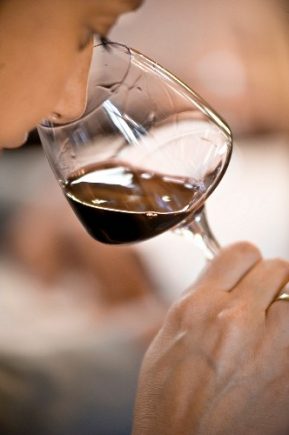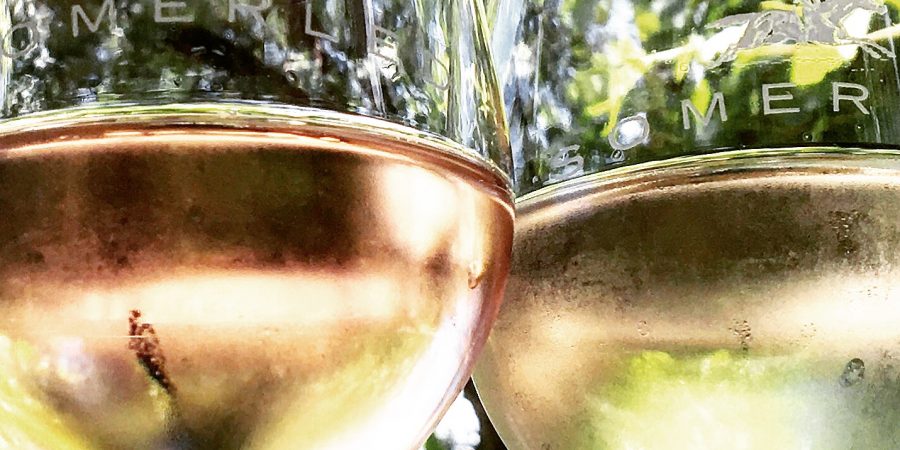So, I think I have one more wine jargon post left in me…
 And this one is going to be full of terms you can pull out when you find yourself face to face with THAT person. You know the one. Maybe it’s a sommelier at a fancy restaurant or the person behind the bar (or even in front of the bar!) at a “not as friendly as Somerled” tasting room.
And this one is going to be full of terms you can pull out when you find yourself face to face with THAT person. You know the one. Maybe it’s a sommelier at a fancy restaurant or the person behind the bar (or even in front of the bar!) at a “not as friendly as Somerled” tasting room.
I think we’ve all met one of these people. They’re the ones who use all the words (even if they’re not really sure what half of them mean!) and make you feel like you should be sipping lemonade at the kiddy table!
Even if you don’t feel comfortable using some of these terms, I’m going to try to help you at least understand what the heck they are going on about. And why not throw one or two of them out there every now and then? After all, you have been following along with this blog so you’re already one up on Joe Average!
 Now, don’t get me wrong. You’ve certainly heard me use many of these words in this very blog. And I hope I don’t come across like that person I just described.
Now, don’t get me wrong. You’ve certainly heard me use many of these words in this very blog. And I hope I don’t come across like that person I just described.
But I know (from personal experience) that when all of these words are thrown at you in a situation that might make you feel a little intimidated in the first place, then it can all be a little overwhelming!
I touched on the basics back in my Wine Jargon Part 1 post a few weeks back (which you may want to revisit), but now let’s take it to the next level…
Angular
Angular means the wine is not round and full and usually has high acidity. Sometimes, an angular wine means it is too young and needs time in the cellar.
I also found this definition thanks to www.winefolly.com which I absolutely love…
“An angular wine is like putting a triangle in your mouth – it hits you in specific places with high impact and not elsewhere. It’s like getting punched in the arm in the same place over and over again.”
Austere
Austere often means hard. The Oxford Dictionary definition of “austere” is “severe or strict in manner or attitude”. These wines are often difficult to drink and don’t have much obvious fruit flavour. They won’t necessarily improve from ageing either.
Attack
The attack is the initial feeling you get when the wine hits your palate.
A good comparison is when you meet someone for the first time and you are being greeted by a handshake (well, not anymore, but cast your minds back and try to remember what that was like!). You can tell a lot about who they are by how firm they shake your hand.
The attack of a wine is the first thing you notice. It might be to do with how fruity or savoury it is. Or perhaps the first thing you notice is the amount of sweetness or acidity.
Balance
There are a few components in wine that holds it together. They are: acid, alcohol, tannin, sugar and water. Balance is when all these components are in harmony with each other. To say a wine is balanced is to say the wine is pleasant and easy to drink.
You’ll definitely notice if the wine is not balanced. For example, if the tannins are not balanced, then the wine is described as being too “tannic” and leaves the mouth feeling unpleasantly dry.
This one can be tricky though, because sometimes really great wines can seem unbalanced if they’re opened too early. Some wines are designed to age, so they might taste a bit out of whack if they’re not left to do their thing.
Just a word on our Somerled wines here though. This is the exact reason (well one of them anyway) why you won’t ever see a young Shiraz (or other bigger reds) in our line-up. Rob likes his wines to be enjoyed now, so he does all that aging for you. What a lovely thing to do… thanks, Rob!
Bright
Used for lively, young, fresh wines. A bright wine is one that is lifted by primary flavours of fresh fruits. They make your mouth water with focused flavor and are usually not heavy in alcohol.
Just think Somerled Sauvigon Blanc… oooops, sorry. I probably shouldn’t have mentioned that…
Chewy
A full-bodied wine, both in texture and flavor with high-tannin structure and thick texture that you almost feel like chewing the wine before swallowing.
Closed
This usually means that the wine is underdeveloped doesn’t really have much in the way of aroma or flavour.
Dense
Think of a bold red wine with concentrated aromas on the nose and palate. It is often used to describe the aroma of a young wine that shows the potential of various aromas and flavours but is too closed to notice each one separately.
Flabby
Flabby means the wine has no acidity. It’s not a positive terma snd isn’t something a winemaker (or anyone else for that matter!) wants to hear.
Flat
A flat wine is one that lacks balance in its structure, particularly in its acidity on the finish.
Grippy
A firmness of texture which is usually from tannins. Wine with grip is hard to drink and better to sip. It helps wines avoid seeming flabby (see above).
Hot
Usually high in alcohol, you can feel the “heat” of these wines on the end of the palate.
Opulent
This word describes the style of wine with a sensuous texture that is rich, bold and smooth. These are the wines you want to be drinking!
Perfumed
A wine that has matured to develop complex aromas similar to that of perfume. Applicable to white wines and some rose wines. Perfumed wines possess a sweet and floral aroma.
Robust
Full-bodied and intense wine.
Structured
Structured describes the relationship or blend of alcohol, tannins, residual sugars, acidity, and fruit in a wine. Similar to “balance”.
Texture or Textural
Texture describes how the wine feels on your palate. Or, more specifically, it’s “mouthfeel”. Imagine textures in a dish with several spices and ingredients that adds to its complexity.
An example would be the buttery, silky mouthfeel of an oaked Chardonnay.
Tight
This wine is not ready to drink. Wine that is described as tight usually has very high tannins, hard-to-identify fruit characteristics and is hard-to-drink. They usually benefit from being decanted.
Vegetal
This one is used to describe characteristics of cooked vegetables detected on the nose and in the flavor. It’s not a desirable quality and usually comes from using unripe grapes.
What became very obvious to me when I was researching this post was that there seem to be various definitions for the same word AND various words for the same definition!
So, if I were you, I wouldn’t get to hung up on all of this.
And even though I know what most of these words mean, but I am still a very big fan of saying “Gee, this wine is really nice”!

It is more than a little scary when i consider that many of the above terms may well apply to my person!
Not at all! The same can be said for me…
The only Jargon that wine needs: MOODY! Lucy, I’m accepting wine donations to ‘seasonal Flu’ stricten Northern Italy.